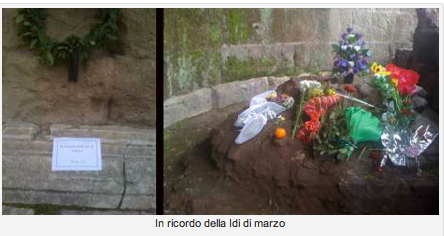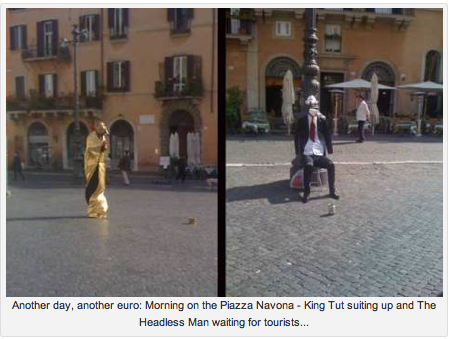As long as I kept the dialog to “buon giorno,” “uno” (when pointing to a particularly remarkable pastry), “grazie” (when buying said pastry) and “sera” (turns out “buona” is optional), the illusion was perfect. I was Roman. So what if I had only the sketchiest of mental maps of the city and came across the Trevi Fountain by chance? Or that my concrete-coddled American legs were no match for the Eternal City’s infernal paving stones? I was Roman enough to have paid my respects at Julius Caesar’s surprisingly humble tomb at the Forum:
At TrackerNews we celebrate the mix and the match, crossing disciplines every chance we get, firmly believing in the the serendipity of collaboration.
It is just plain easier to think outside the box when at least one person in a group isn’t in it. It also improves the odds for generating new ideas and breakthrough answers. The rest of Eva’s class was full of the usual mix of poly-sci, history and econ majors. How could the addition of someone with a little background in psychology be anything but a plus?
TrackerNews was designed with the Eva’s of the world in mind. The typical news aggregator skews to dateline or popularity. TrackerNews skews to contextual relevance, focusing on connections. We seek out what automated RSS feeds routinely miss: research papers, older news stories, author interviews, the brilliant one-off’s. The mission is quality over quantity in the day-to-day and archival depth over time.
THE LESSONS OF LEONARDO
When I bought my Kindle a few months back, in the pre-iPad era, I knew it would turn out to be the “8-track cassette” of e-readers: a good-enough idea until something less idiosyncratic came along. Its klutzy set-up for creating and accessing notes has indeed proved annoying, though still not a bad way to haul around a lot of books.
I traveled through Italy reading Fritjof Capra’s,“The Science of Leonardo.” Ironically, thatwas made possible because as a bastard offspring, he had skipped university. This lack of formal education had been a sore spot at the time, but allowed Leonardo the the freedom to think in new ways. Eventually, he read all the classic texts on his own, spared having to take the tests proving he had interpreted them “correctly.”
Instead, after what sounds like a fairly idyllic childhood spent roaming the Tuscan hills as a budding naturalist, Leonardo was apprenticed to a sculptor in Florence. The studio was where Art met Science and Engineering. Practical know-how—how to weld, how to cast, how to hoist, how to handle different materials and how to design for durability—were simply part of the job. It was a perfect spot for a natural-born “systems thinker” with a talent for spotting patterns that could be applied from one field to another.
…Leonardo da Vinci was the first in long line of scientists who focused on the patterns interconnecting basic structures and processes of living systems. Today, this approach is called ‘systemic thinking.’ This, in my eyes, is the essence of what Leonardo meant by farsi universale. Freely translating his statement into modern scientific language, I would rephrase it this way: ‘For someone who can perceive interconnecting patterns, it is easy to be a systemic thinker.’
BACK ON THE PIAZZA: CHINA, GENDERCIDE, CONGO, CLIMATE CHANGE & A THESISEva listened attentively to my soapbox rant on TrackerNews, Leonardo and the endless benefits of omnivorous curiosity and multifaceted perspective. How, she asked, might that apply to a somewhat pressing personal and very specific problem, namely, coming up with a thesis topic: “Something about China.”
“Easy,” I replied. “Find a couple of major trends that look likely to intersect and analyze the implications. Take a multi-disciplinary approach, look for patterns and try to figure out how all the moving parts will interact and change over time. Think like Leonardo!”
So… China. No shortage of material there. I suggested two trends we’ve covered onTrackerNews: demographic skew and natural resource depletion.
- One of the most important sit-up-and-take-notice stories of the decade, if not the century, is The Economist’s “The Worldwide War on Girls,”which takes a hard look at the consequences of a China’s one-child policy and boy-centric tradition. Beyond the disturbing ethical issues of sex-selective abortion and infanticide – “gendercide” – it is estimated there will soon be 40 million more Chinese men of marriageable age than Chinese women for them to marry. That’s enough extra men to fill 5 New York Cities. What will become of them?
- An equally disturbing story is Richard Behar’s 2008 6-part tour de force for Fast Company, “China Storms Africa.” The Chinese, flush with of cash but running low on natural resources, are on a raw materials buying spree, with serious global power-shift and environmental ramifications. Although the specter of oil palm plantations is only a tiny part of a much larger story, it has the potential to affect the entire planet. Consider: The island of Borneo has slashed and
- burned its way to the #3 spot of global CO2 emitters, right behind the U.S. and China, by clearning rain forests to make way for these biodiversity-annihilating plantations. In the summer of 2009, a Chinese company announced plans for a 1 million hectare – 3,800 square mile – operation in the Democratic Republic of Congo
Will China’s man-surplus be funneled into an ever-expanding military machine? Will they be deployed around the world to defend the nation’s growing foreign interests? What does this mean for Africa over the next 10, 20, 50, 100 years? For global climate change? For the global economy? What happens to China? Will the extra men marry foreign women? Will Chinese women find themselves in a position of power, sought after and valued? Or shut out of a giant boys’ club? What kind of political force will these extra men present?
We stood in the piazza riffing for almost a half hour. These big picture issues don’t come up nearly enough in the conversations of humanitarian aid workers, social entrepreneurs, environmentalists or policy-makers. What a kick it would be if this accidental conversation actually led to Eva’s thesis.
Why it would be just the kind of thing we would post on TrackerNews…












